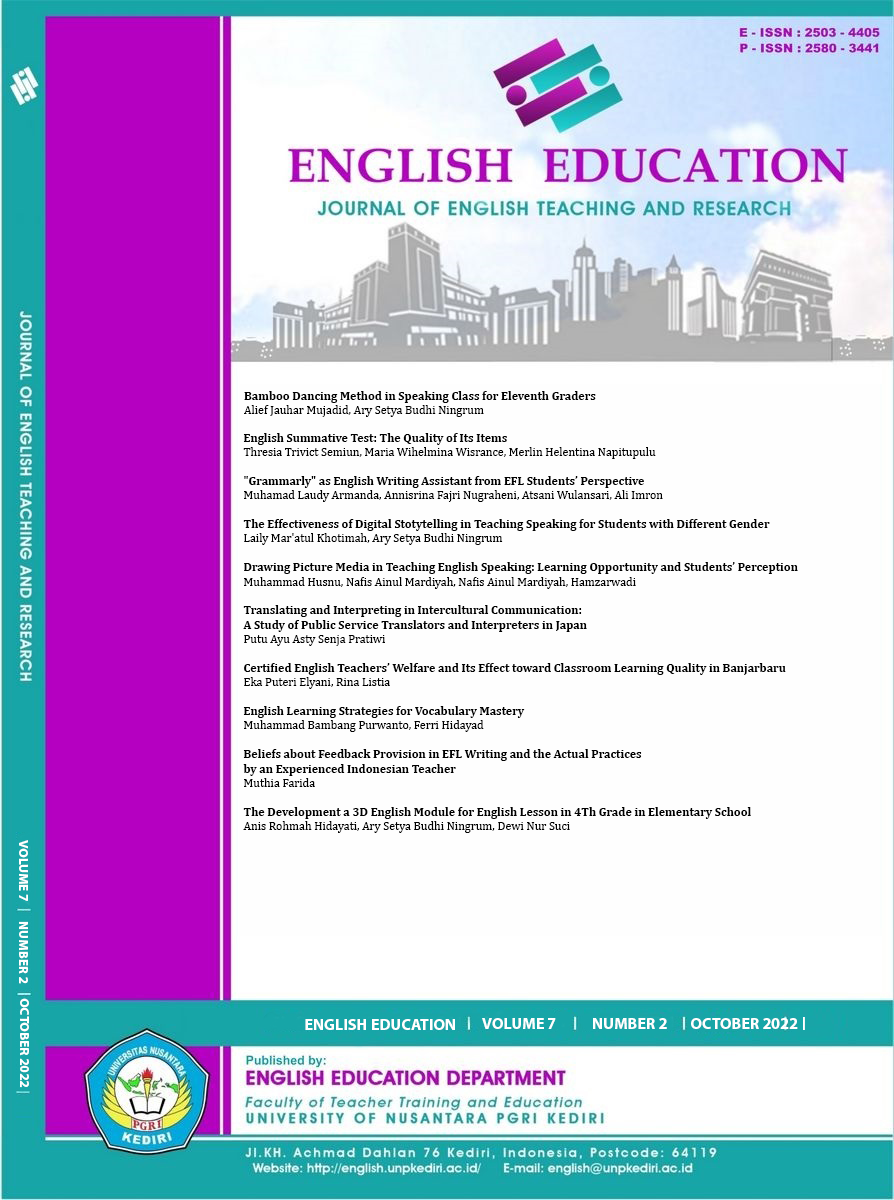English Summative Test: The Quality of Its Items
DOI:
https://doi.org/10.29407/jetar.v7i2.18347Keywords:
items, the quality, English summative testsAbstract
It is crucial to implement evaluation after the teaching and learning process. Evaluation will reflect the success of teaching and more important the achievement of the students. Therefore, EFL teachers should develop a good test to measure students' achievement. This study analyzed multiple-choice items of English summative tests constructed by junior high school EFL teachers in Kupang, NTT. The result of this analysis functions as feedback to the English teachers on the quality of English summative tests they had created. This research was descriptive research with documentation for data collection.The English summative tests for grades VIII and IX were collected and then analyzed by using ITEMAN software to reveal item difficulty, item discrimination, and distracters effectiveness of the tests. The findings revealed that the English summative tests were developed with easy items. However, the tests still had a good discriminatory level. The test items which had all distracters perform well were only half of the total items.
Downloads
References
Allen, M. (2004). Assessing academic programs in higher education. Bolton: Anker Publishing Company, Inc.
Arifin, Z. (2013). Evaluasi pembelajaran: prinsip, teknik, prosedur. Bandung: PT. Remaja Rosdakarya.
Bachman, L. F., & Palmer, A. S. (1996). Language testing in practice. Designing and developing useful language tests. New York: Oxford University Press.
Brown, H. D. (2004). Language assessment. Principles and classroom practices. New York: Pearson Education, Inc.
Cizek, G., & O’Day, D. (1994) Further investigation of nonfunctioning options in multiplechoicetest items. Educational and Psychological Measurement, 54, 861-872. doi:http://dx.doi.org/10.1177/0013164494054004002
Danuwijaya, A. A. (2018). Item analysis of reading comprehension test for postgraduate students. English Review: Journal of English Education, 7(1), 29-40. doi: 10.25134/erjee.v7i1.1493.
DiBattista, D., & Kurzawa, L. (2011). Examination of the quality of multiple-choice items on classroom tests.The Canadian Journal for the Scholarship of Teaching and Learning, 2(2). doi:https://doi.org/10.5206/cjsotl-rcacea.2011.2.4
Djiwandono, S. (2011).Tes Bahasa. Pengangan bagi pengajar bahasa (2nd ed.). Jakarta: PT. Indeks Jakarta.
Fraenkel, J. & Wallen, N. (2006). How to design and evaluate research in education (6th ed.). New York: McGraw-Hill.
Gronlund, N. E. (1982). Measurement and evaluating in teaching (4th ed.). New York: Macmillan
Gronlund, N. E. (1998). Assessment of student achievement (6th ed.). Boston: Allyn and Bacon
Hadi, S. & Kusumawati. (2018). An analysis of multiple-choice qustions (mcqs): item and test statistics from Mathematics assessments in senior high school. Research and Evaluation in Education, 4(1), 70-78. doi:https://doi.org/10.21831/reid.v4i1.20202
Haladyna, T. M., & Downing, S. M. (1993). How many options is enough for a multiple-choice test item? Educational and Psychological Measurement, 53(4), 999 1010. doi:https://doi.org/10.1177/0013164493053004013
Karim, S. A., Sudiro, S., & Sakinah, S. (2021). Utilizing test items analysis to examine the level of difficulty and discriminating power in a teacher-made test. EduLite: Journal of English Education, Literature, and Culture, 6 (2), 256-269. http://dx.doi.org/10.30659/e.6.2.256-269
Koretz, D. (2002). Limitation in the Use of Achievement Tests as Measures of Educators Productivity. The Journal of Human Resource, 37(4), 752-777. doi:https://doi.org/10.2307/3069616
Maharani, A. & Putro, N. (2020). Item analysis of English final semester test. Indonesian Journal of EFL and Linguistics, 5(2), 491-504. doi:http://dx.doi.org/10.21462/ijefl.v5i2.302
Nana, E. (2018). An analysis of English teacher-made tests. State University of Makasar.
Pradanti, S., Martono, M., & Sarosa, T. (2018). An Item Analysis of English Summative Test for The First Semester of The Third Grade Junior High School Students in Surakarta. English Education Journal, 6(3), 312-318. doi:https://doi.org/10.20961/eed.v6i3.35891
Rudner, L.M. and Schafer, W.D. (2002). What teachers need to know about assessment. Washington DC : National Education Association.
Salwa, A. (2012). The validity, reliability, level of difficulty and appropriateness of curriculum of the English test. Diponegoro University.
Santyasa, I, W. (2005). Analisis Butir dan Konsistensi Internal Tes, (Online), http://johannes.lecture.ub.ac.id.
Suharsimi, A. (2010). Dasar-Dasar Evaluasi Pendidikan, Jakarta: Bumi Aksara.
Setiyana R. (2016). Analysis of summative tests for English. EEJ 7(4), 433-447. doi:https:// 10.35308/ijelr.v2i2.2781
Semiun, T., & Luruk, F. (2020). The quality of an English summative test of a public junior high school, Kupang-NTT. English Language Teaching Educational Journal, 3(2), 133-141. doi:https://doi.org/10.12928/eltej.v3i2.2311
Tarrant, M., Ware, J. & Mohammed, A.M. (2009). An assessment of functioning and non-functioning distractors in multiple-choice questions: a descriptive analysis. BMC Med Educ 9, 40- https://doi.org/10.1186/1472-6920-9-40
Wells, C. S., & Wollack, J. A. (2003). An instructor’s guide to understanding test reliability. Madison: University of Wisconsin.
Downloads
Published
Issue
Section
License
Authors who publish with this journal agree to the following terms:
- Copyright on any article is retained by the author(s).
- The author grants the journal, the right of first publication with the work simultaneously licensed under a Creative Commons Attribution License that allows others to share the work with an acknowledgment of the work’s authorship and initial publication in this journal.
- Authors are able to enter into separate, additional contractual arrangements for the non-exclusive distribution of the journal’s published version of the work (e.g., post it to an institutional repository or publish it in a book), with an acknowledgment of its initial publication in this journal.
- Authors are permitted and encouraged to post their work online (e.g., in institutional repositories or on their website) prior to and during the submission process, as it can lead to productive exchanges, as well as earlier and greater citation of published work.
- The article and any associated published material is distributed under the Creative Commons Attribution-ShareAlike 4.0 International License








 Article template
Article template



